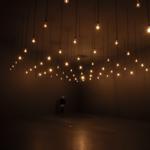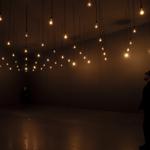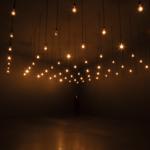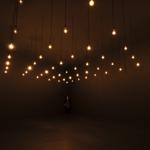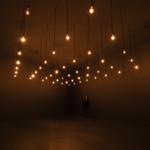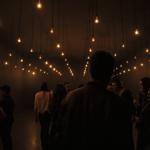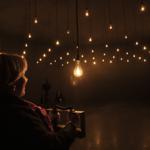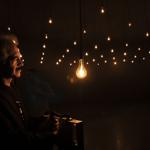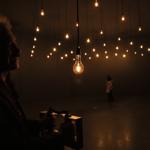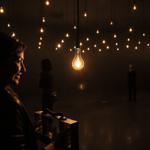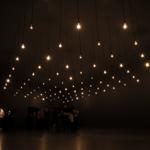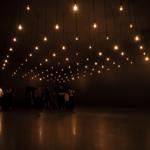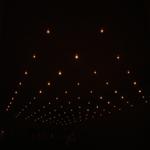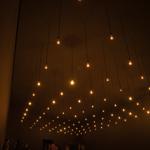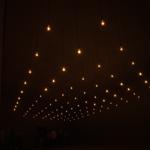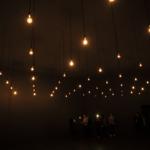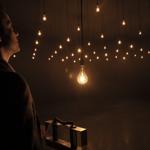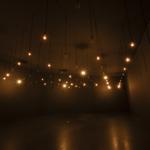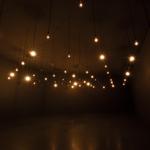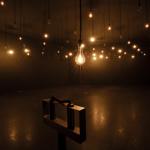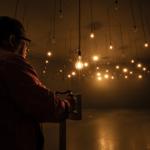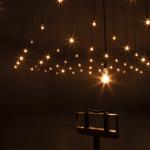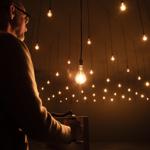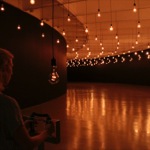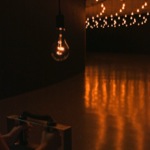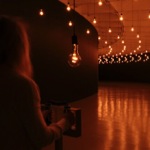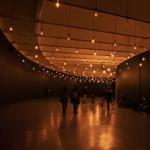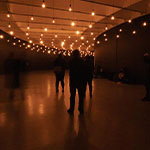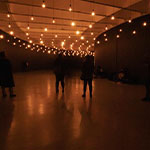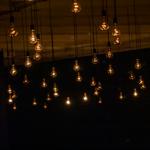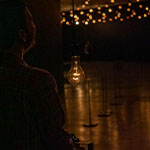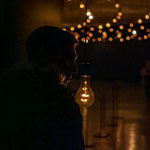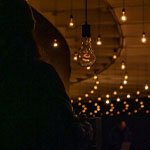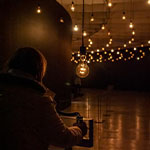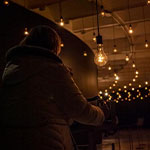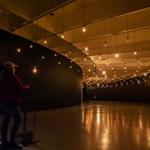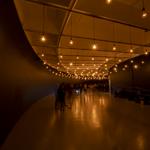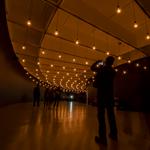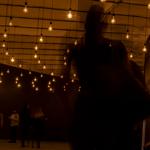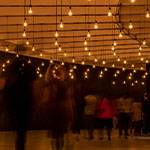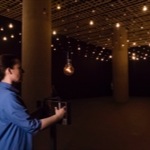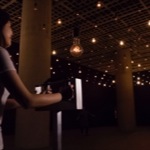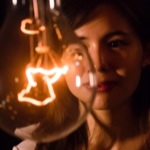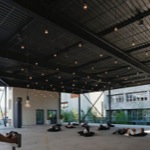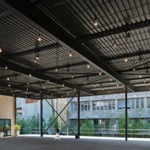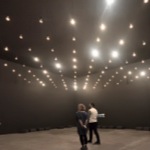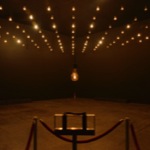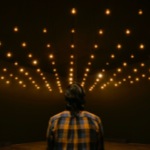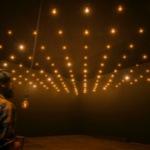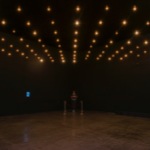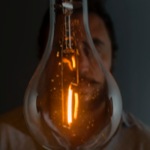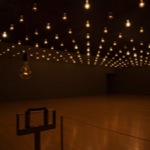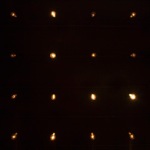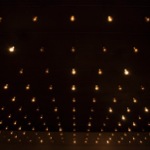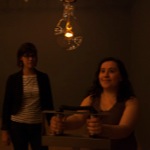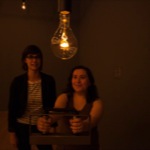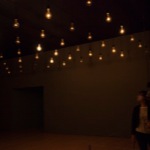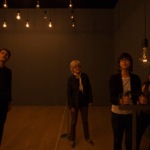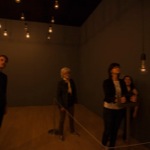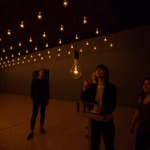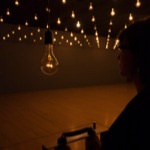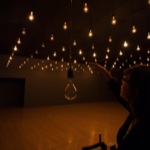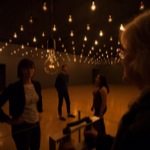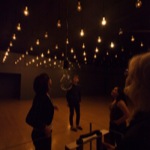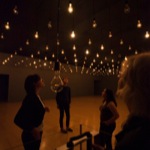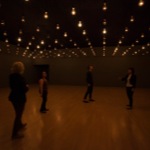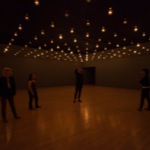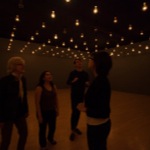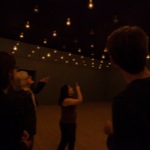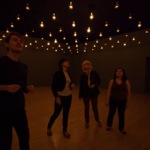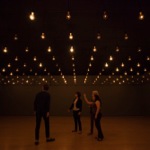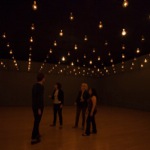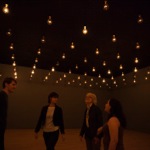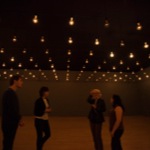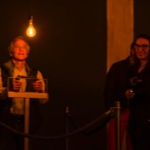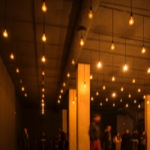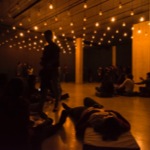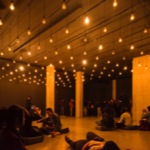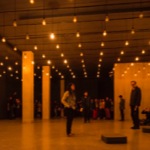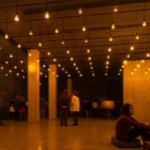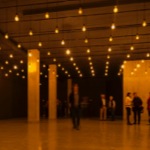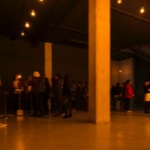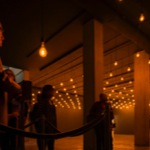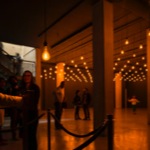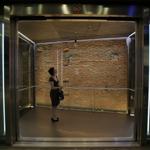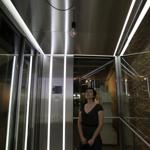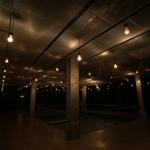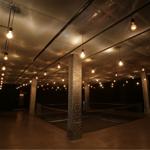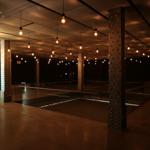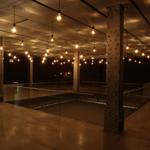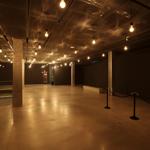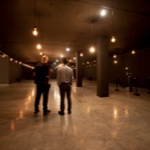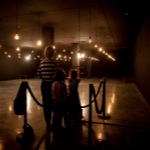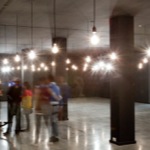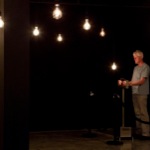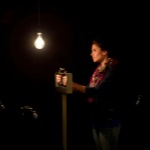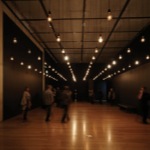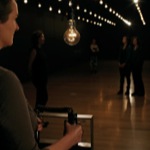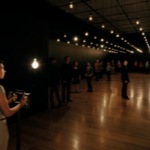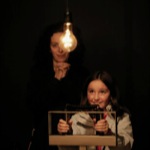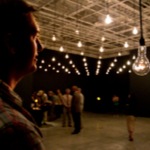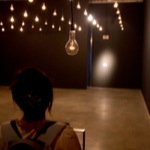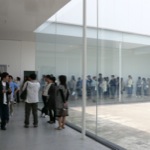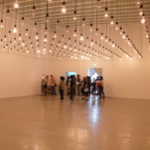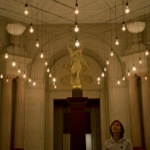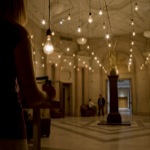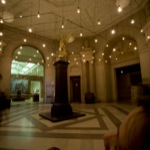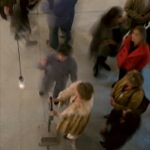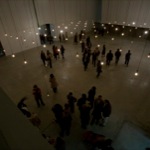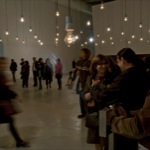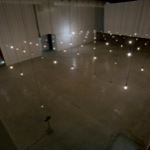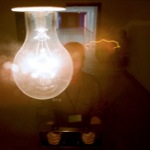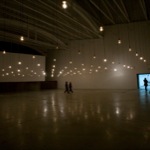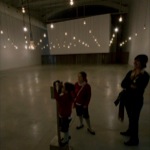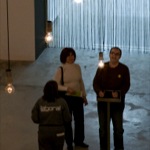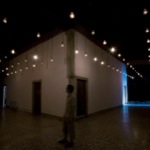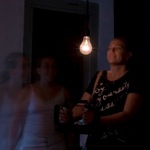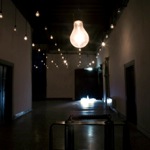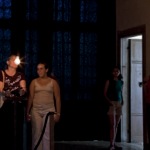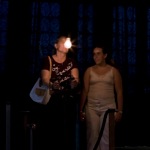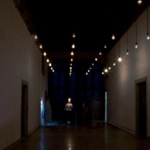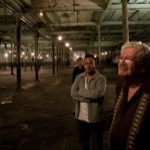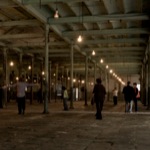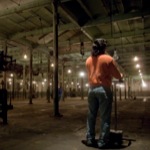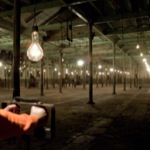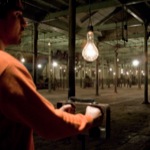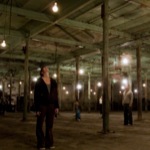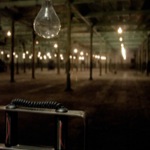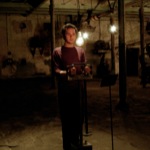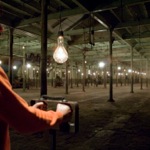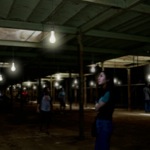Pulse Room
“Pulse Room” is an interactive installation featuring one to three hundred clear incandescent light bulbs, 300 W each and hung from a cable at a height of three metres. The bulbs are uniformly distributed over the exhibition room, filling it completely. An interface placed on a side of the room has a sensor that detects the heart rate of participants. When someone holds the interface, a computer detects his or her pulse and immediately sets off the closest bulb to flash at the exact rhythm of his or her heart. The moment the interface is released all the lights turn off briefly and the flashing sequence advances by one position down the queue, to the next bulb in the grid. Each time someone touches the interface a heart pattern is recorded and this is sent to the first bulb in the grid, pushing ahead all the existing recordings. At any given time the installation shows the recordings from the most recent participants.
This work was inspired by Macario, directed by Roberto Gavaldón in 1960, a film where the protagonist suffers a hunger-induced hallucination in which every person is represented by a lit candle in a cave. Other references for this work include minimalist, machinic and serialist patterns in music (for example in scores by composers Conlon Nancarrow, Steve Reich and Glenn Branca) and the postulation of the theory of Cybernetics at the National Institute of Cardiology in Mexico City to explain the process of self-regulation of the heart.
Macario sequence
This work was inspired by Macario, directed by Roberto Gavaldón in 1960, a film where the protagonist suffers a hunger-induced hallucination in which every person is represented by a lit candle in a cave. Other references for this work include minimalist, machinic and serialist patterns in music (for example in scores by composers Conlon Nancarrow, Steve Reich and Glenn Branca) and the postulation of the theory of Cybernetics at the National Institute of Cardiology in Mexico City to explain the process of self-regulation of the heart.
Macario sequence
General info
Spanish name:
Almacén de Corazonadas
Year of creation:
2006
100 bulbs version
Technique:
incandescent light bulbs, voltage controllers, heart rate sensors, computer and metal sculpture
Dimensions:
variable
Keywords:
Edition:
3 Editions, 1 AP
Collectors:
Fundación Jumex Arte Contemporáneo, Museum of Modern Art, Museum of Old and New Art and private collector
300 bulbs version
Technique:
incandescent light bulbs, voltage controllers, heart rate sensors, computer and metal sculpture
Dimensions:
variable
Keywords:
Edition:
1 Edition, 1 AP
Collectors:
21st Century Museum of Contemporary Art, Musée d'art contemporain de Montréal
Exhibitions
- What Is Left Unspoken, Love, High Museum of Art, Atlanta, Georgia, United States, 2022.
- Rafael Lozano-Hemmer: Latidos, Arte Abierto, Mexico City, México, 2020.
- Rafael Lozano-Hemmer: Pulse, Hirshhorn Museum and Sculpture Garden, Washington, D.C., United States, 2018 - 2019.
- Rafael Lozano-Hemmer: Decision Forest, Amorepacific Museum of Art, Seoul, South Korea, 2018.
- Pulse Room, Museum of Old and New Art, Hobart, Tasmania, Australia, 2017.
- Rafael Lozano-Hemmer: Preabsence, Haus der Elektronischen Künste Basel, Basel, Switzerland, 2016.
- Rafael Lozano-Hemmer: Pseudomatismos, Museo Universitario Arte Contemporaneo, Mexico City, México, 2015 - 2016.
- Rafael Lozano-Hemmer: A Draft of Shadows, Bildmuseet, Umeå, Sweden, 2014 - 2015.
- Rafael Lozano-Hemmer: Signos e Índices, NC-arte, Bogotá, Colombia, 2014 - 2015.
- La Beautée du Geste / The Grace of a Gesture, Musée d'Art Contemporain de Montréal, Montréal, Québec, Canada, 2014.
- Rafael Lozano-Hemmer: Abstracción Biométrica, Borusan Contemporary, Espacio Fundación Telefónica, Madrid, Spain, 2014.
- Pulse Room, IZOLYATSIA, Platform for Cultural Initiatives, Donetsk, Ukraine, 2013 - 2014.
- The Red Queen, Museum of Old and New Art, Hobart, Tasmania, Australia, 2013 - 2014.
- Son et Lumière, 21st Century Museum of Contemporary Art, Kanazawa, Japan, 2012 - 2013.
- WBA3: Architecture in the Expanded Field, Wattis Institute of Contemporary Art in San Francisco, San Francisco, California, United States, 2012.
- Rafael Lozano-Hemmer: Recorders, Museum of Contemporary Art, Sydney, Australia, 2011 - 2012.
- Monanism, Museum of Old and New Art, Hobart, Tasmania, Australia, 2011 - 2014.
- Pulse Show, Beall Center, University of California, Irvine, California, United States, 2010 - 2011.
- Rafael Lozano-Hemmer: Recorders, Manchester Art Gallery, Manchester, United Kingdom, 2010 - 2011.
- Artefact Festival, Leuven, Belgium, 2010.
- Emergentes, Fundación Telefónica, Santiago, Chile, 2009.
- Enter Action-Digital Art Now, ARoS Aarhus Kunstmuseum, Aarhus, Denmark, 2009.
- Hundred Stories about Love, 21st Century Museum of Contemporary Art, Kanazawa, Japan, 2009.
- Rafael Lozano-Hemmer: Recorders, Edith Russ Haus für Medienkunst, Oldenburg, Germany, 2008.
- Emergentes, Centro Fundación Telefónica, Lima, Perú, 2008.
- Emergentes, Espacio Fundación Telefónica, Buenos Aires, Argentina, 2008.
- In Memoriam Albert Hofmann, Laberinto de la Ciencia y Las Artes, Jumex Collection, San Luis Potosí, México, 2008.
- Intruders, Musée national des beaux-arts du Québec, Québec, Québec, Canada, 2008.
- Emergentes, The Laboral Art Center, Gijón, Spain, 2007.
- Some Things Happen More Often Than All Of The Time, Mexican Pavilion, 52 Biennale di Venezia, Venice, Italy, 2007.
- Plataforma, Fábrica La Constancia, Puebla, México, 2006.
Credits
- Programming: Conroy Badger
- Production Assistance: David Lemieux, Natalie Bouchard, Pierre Fournier
- Co-produced by: the non-profit organization Puebla 2031, A.C. for the exhibition Plataforma 06, in Puebla, Mexico, where it was shown for the first time
- Currently in the following collections: Karin Srb (Germany), Jonathon Carroll (NYC), Museum of Old and New Art (Australia), Jumex Collection (Mexico)
Bibliography
- "Ohne Besucher keine Ausstellung: Rafael Lozano-Hemmer nimmt das wörtlich." Tages Woche, 9 June 2016. Basel, Switzerland, 2016. (deutsch) (Newspapers)
- "Rafael Lozano-Hemmer 'Preabsence' at House of Electronic Arts, Basel." Mousse Magazine, 23 June 2016. Milan, Italy, 2016. (english) (Magazines)
- "“The 10 best museum shows to see in Basel this week.” Artnet News. 13 June 2016. Web. 16 June 2016. (english)." Artnet News, 13 June 2016. New York City, New York, United States, 2016. (english) (Websites)
- "Rafael Lozano-Hemmer. Pseudomatismos." Kybernautas, 1 Mar. 2016. México, 2016. (español) (Websites)
- "Rafael Lozano-Hemmer: Pseudomatismos." Dad Calls Me Weirdo, 21 Jan. 2016. 2016. (english) (Websites)
- "The serious relationship of art and technology." Widewalls, 2016. Ermatingen, Switzerland, 2016. (english) (Websites)
- "10 exposiciones imprescindibles de 2015 (julio-diciembre)." Código, 29 June 2015. Mexico City, México, 2015. (Magazines)
- "Interaktiva installationer och kubansk samtidskonst." Allt Om Västerbotten, 8 Mar. 2015. Sweden, 2015. (svenska) (Websites)
- "Visionarios: Rafael Lozano-Hemmer, creador de arte vivo." The Creators Project, 9 Dec. 2015. New York City, New York, United States, 2016. (español) (Websites)
- "Exhibe MUAC evolución artística de Rafael Lozano-Hemmer." 20 Minutos México, 3 Nov. 2015. Madrid, Spain, 2015. (español) (Newspapers)
- "Rafael Lozano-Hemmer." ArtNexus, 27 Nov. 2015. Bogotá, Colombia, 2016. (english) (Magazines)
- "Rafael Lozano-Hemmer: Pseudomatisms." Digicult, 12 Nov. 2015. Milan, Italy, 2016. (english) (Websites)
- "Pseudomatismos: Una exposición imperdible en el MUAC." City Express Hotels, Nov. 2015. Mexico City, México, 2016. (Websites)
- "Exhibe el MUAC Pseudomatimos, la primera exposición monográfica de Rafael Lozano-Hemmer en México." Cultura UNAM, Nov. 2015. Mexico City, México, 2016. (español) (Websites)
- "Agenda de la semana: coleccionar cultura." Forbes México, Nov. 2015. Mexico City, México, 2016. (Magazines)
- "Pseudomatismos, de Rafael Lozano-Hemmer muestra la luz en el arte." Zona Franca, 30 Oct. 2015. Guanajuato, México, 2015. (español) (Websites)
- "Rafael Lozano-Hemmer. Pseudomatisms." E-flux, 29 Oct. 2015. New York City, New York, United States, 2015. (english) (Websites)
- "Lozano-Hemmer en el MUAC." La Tempestad, 2 Oct. 2015. Mexico City, México, 2015. (español) (Magazines)
- "Pseudomatismos de Rafael Lozano-Hemmer." GASTV, Oct. 2015. México, 2015. (español) (Websites)
- "La abstracción biométrica de Lozano-Hemmer.." Más de Arte, 7 May 2014. Madrid, Spain, 2014. (español) (Websites)
- "Rafael Lozano-Hemmer: Investigar la vida artificial es investigarnos a nosotros mismos.." Espacio Fundación Telefónica, 12 May 2014. Madrid, Spain, 2014. (español) (Websites)
- "La huella de Lozano-Hemmer." Fundación Telefónica Madrid, 28 Nov. 2014. Madrid, Spain, 2015. (español) (Websites)
- "Artista Lozano-Hemmer presenta en Bogotá su obra corazonadas y suspiros." El Universal, 25 Oct. 2014. Caracas, Venezuela, 2015. (español) (Newspapers)
- "Signos e Índices, sinergia artística con la tecnología." El Nuevo siglo, 22 Oct. 2014. Bogotá, Colombia, 2015. (español) (Newspapers)
- "The Red Queen." Museum of Old and New Art, 2013. Hobart, Tasmania, Australia. (english) (Books)
- "Son et Lumière: Material, Transition, Time and Wisdom." 21st Century Museum of Contemporary Art, 2012. Kanazawa, Japan. (english and japanese) (Books)
- "Rafael Lozano-Hemmer." Emergentes, 2008. Buenos Aires, Argentina. (english and español) (Books)
- "Rafael Lozano-Hemmer: Artista Visual." La Tempestad, Vol. 8 No. 53 March-April, 2007. Mexico City, México. (español) (Magazines)
- Aldana, Luisa. "Rafael Lozano-Hemmer." Estética y Conocimiento, 26 Apr. 2016. 2016. (español) (Websites)
- Andersson, Cecilia. "Entrevista: Rafael Lozano-Hemmer." Exit Express, Nov. 2007. Madrid, Spain, 2011. (español) (Magazines)
- Aros. "Pulse room: Rafael Lozano-Hemmer." Enter action: digital art now, 2009. Aarhus, Denmark. (english and dansk) (Books)
- Ávila, Sonia. "El MoMA amplía colección mexicana." Excelsior, 28 Jan. 2015. Mexico City, México, 2015. (español) (Newspapers)
- Azael Hernández, Diego . "Pseudomatismos, arte y tecnología en el MUAC." La Liebre de Fuego, 27 Nov. 2015. México, 2016. (español) (Websites)
- Barro, David. "Rafael Lozano-Hemmer." Emergentes, 2008. Gijón, Spain. (english and español) (Books)
- Barro, David. "Arte y ciencia del comportamiento." El Cultural, 22 Nov. 2007. Madrid, Spain. (español) (Magazines)
- Carlson, Merete & Ulrik Schmidt. "Pulse on pulse: modulation and signification in Rafael Lozano-Hemmer's Pulse Room." Journal of Aesthetics & Culture, 2012. 2017. (english) (Magazines)
- Catlin, Roger. "This Art Show Is Taking the Literal Pulse of America." Smithsonian Magazine, 6 Nov. 2018. Washington, D.C., United States, 2021. (english) (Magazines)
- Cermeño, Luis. "Conferencia de Burbano: Entre cibernética y vida artificial en NC-arte." Mil Inviernos, 11 Mar. 2015. 2015. (español) (Websites)
- Chardon, Elisabeth. "A Bâle, des ouvres qui pulsent au rythme de votre coeur." Le Temps, 8 Aug. 2016. Genève, Switzerland, 2016. (français) (Newspapers)
- Chaykowski, Natasha . "Different Heartbeats: Rafael Lozano-Hemmer's Pulse Room." Canadian Art, 23 July 2014. Toronto, Ontario, Canada, 2014. (english) (Magazines)
- Clayton, Richard. "An interactive show with unsettling devices." Financial Times, 17 Sep. 2010. London, United Kingdom, 2010. (english) (Newspapers)
- Cohen, Carla . "La luz de un latido - Rafael Lozano-Hemmer en el MUAC." Mexicanísimo, 9 Nov. 2015. Mexico City, México, 2016. (español) (Magazines)
- Cordellat, Adrián.. "El silencio, como las sombras, nos brinda momentos que nos permiten reflexionar sobre lo posible." El Diario Fénix, 15 May 2014. Madrid, Spain, 2014. (español) (Newspapers)
- Cordero, Patricia. "Prende artista 100 focos con latidos. Roba corazones Lozano-Hemmer." Reforma, 27 Oct. 2006. Mexico City, México. (español) (Newspapers)
- Cuellar Ledesma, Diana. "Rafael Lozano-Hemmer: Abstracción biométrica." Los Apuntes de la Cazadora, 27 Nov. 2014. Madrid, Spain, 2015. (español) (Websites)
- Da Silva, Jose, et al.. "Six shows to see during Art Basel." The Art Newspaper, 14 June 2016. London, United Kingdom, 2016. (english) (Newspapers)
- Del Conde, Teresa. "Lozano-Hemmer en el MUAC." La Jornada, 1 Dec. 2015. Mexico City, México, 2016. (español) (Newspapers)
- Del Río, Enrique.. "Si el arte no cuestiona la realidad es una mierda.." Hoy es arte, 20 May 2014. Madrid, Spain, 2014. (español) (Newspapers)
- Dingfelder, Sadie. "This New Hirshhorn Exhibit Will Turn Your Heart Into Art." The Washington Post, 30 Oct. 2018. Washington, D.C., United States, 2021. (english) (Newspapers)
- Dorner, Jennifer. "Governor General's Awards in Visual and Media Arts - Rafael Lozano-Hemmer media artist." Canada Council for the Arts, Mar. 2015. Ottawa, Ontario, Canada, 2015. (english) (Websites)
- Eckersley, Nicole. "Valentine's Day synchronicity: heartbeats make music in Melbourne park." The Guardian, 14 Feb. 2017. London, United Kingdom, 2017. (english) (Newspapers)
- edited by Ulrik Ekman. "Throughout: Art and culture Emerging with Ubiquitous Computing." The MIT Press, 2013. Cambridge, Massachusetts, United States. (english) (Books)
- Eggleton, Lara. "How I learned to stop worrying and love the throngs." folly matters, 19 Dec. 2014. Leeds, United Kingdom, 2015. (english) (Websites)
 Fagone, Chiara. "Rafael Lozano-Hemmer: progettare l'imprevedibile designing the unexpected." D-Lux, No. 5, Apr. 2009. Milan, Italy. (english and italiano) (Magazines)
Fagone, Chiara. "Rafael Lozano-Hemmer: progettare l'imprevedibile designing the unexpected." D-Lux, No. 5, Apr. 2009. Milan, Italy. (english and italiano) (Magazines)- Federico, Cherie. "Digital Art and the Platforms for Participation." Aesthetica, Aug. 2010, 30-33. York, United Kingdom. (english) (Magazines)
- Fernando Gómez Echeverri. "200 almas / La feria del arte." El Tiempo, 26 Oct. 2014. Bogotá, Colombia, 2014. (español) (Newspapers)
 Finkel, Jori. "Hooked on the 'pulse'." Los Angeles Times, 17 Oct. 2010. Los Angeles, California, United States. (english) (Newspapers)
Finkel, Jori. "Hooked on the 'pulse'." Los Angeles Times, 17 Oct. 2010. Los Angeles, California, United States. (english) (Newspapers)- Flakke Johannessen, Adele. "Biorhythms." Volta Magazine, Nov. 2012. Spain. (english) (Magazines)
- García, Daniela. "El arte electrónico de Rafael Lozano-Hemmer." Revista Axxis, 4 Dec. 2014. Bogotá, Colombia, 2015. (español) (Magazines)
- García La Rota, Andres. "Rafael Lozano-Hemmer, de pulsaciones, vigilancia y el arte tecnológico." El Tiempo, 30 Oct. 2014. Bogotá, Colombia, 2014. (español) (Newspapers)
- Gimonnet, Bénédicte. "'Pulse Corniche' seeing through light." Madame Magazine, 1 Jan. 2015. Dubai, United Arab Emirates, 2015. (Magazines)
- Goddard, Peter. "At the Biennale. From our skyline to Venetian back alleys." Toronto Star, 21 June 2007. Toronto, Ontario, Canada. (english) (Newspapers)
- Gómez Haro, Germaine. "La feria de arte en Bogotá." La Jornada Semanal, 16 Nov. 2014. Mexico City, México, 2015. (español) (Magazines)
- Gómez Haro, Germaine. "México en la Bienal de Venecia." La Jornada Semanal, 2 Sep. 2007. Mexico City, México. (español) (Newspapers)
- Gómez, Jocelyn. "Rafael Lozano-Hemmer expone Pseudomatismos en Ciudad de México." Designboom, 14 Nov. 2015. Milan, Italy, 2016. (español) (Websites)
- Graham, Beryl, and Sarah Cook. "The behaviors of new media towards a post-hype hostipitality aesthetics?." Art Lies, no. 949, 2010. Houston, Texas, United States. (english) (Magazines)
- Greenham, Pere. "El gran hermano, "Pseudomatismos" de Rafael Lozano Hemmer." Blasting News, 26 Jan. 2016. Chiasso, Switzerland, 2016. (español) (Websites)
- Guardado Velasco, Patricia. "Las 5 mejores exposiciones del 2016 en México." El Mexiqueño, 5 Dec. 2016. México, 2017. (español) (Websites)
- Hamdan, Lubna. "Abu Dhabi launches light installation based on users' heart rates." Arabian Business, 8 Jan. 2015. Dubai, United Arab Emirates, 2015. (english) (Magazines)
- Hernández, Edgar A.. "Cae en coma, curador de la bienal veneciana." Comunidad, 6 June 2007. Mexico City, México. (español) (Newspapers)
- Herrera, Adriana. "Lozano-Hemmer: conmover al mundo." Poder y Negocios, 3 June 2008. Mexico City, México, 2015. (español) (Magazines)
- Jasso, Klara. "Questions per Minute - Rafael Lozano-Hemmer." Codigo 06140, Dec. 2010. Mexico City, México, 2011. (español) (Magazines)
- Kalsi, Jyoti. "Feel the pulse of Abu Dhabi." Gulf News, 7 Jan. 2015. Dubai, United Arab Emirates, 2015. (english) (Newspapers)
- Károly, Karola. "Rendbontó szívraktár." Kultúrpart, 1 Dec. 2014. Hungary, 2015. (magyar) (Websites)
- Katz, Andrew. "Top five 2014 exhibitions (Experiences) from associate publisher: Andrew Katz." New American Paintings, 19 Dec. 2014. Boston, Massachusetts, United States, 2015. (english) (Websites)
- Katz, Miriam. "Rafael Lozano-Hemmer." Artforum, 20 Feb. 2009. New York City, New York, United States, 2013. (english) (Magazines)
- Khan, Sawaiba. "New art project will show your heartbeat in lights above UAE." What's On, 6 Jan. 2015. Dubai, United Arab Emirates, 2015. (english) (Websites)
- Letechipía, Yanett R.. "RAFAEL LOZANO-HEMMER, FUSIÓN ENTRE ARTE, TECNOLOGÍA E INTERACTIVIDAD." Creación Híbrida, 9 May 2023. 2023. (español) (Websites)
- Lomelí, Natalia. "11 arquitectos y artistas que debes conocer para entender las transformaciones del mundo." Cultura Colectiva, 24 Feb. 2017. Mexico City, México, 2017. (español) (Websites)
- Loos, Ted. "Rafael Lozano-Hemmer Is a Crowd Pleaser. He’s Also Obsessed With Death." The New York Times, 26 Oct. 2018. New York City, New York, United States, 2021. (english) (Newspapers)
- Lozada, Priamo, and Bárbara Perea. "Rafael Lozano-Hemmer - 'Some things happen more often than all the time'." Kunstforum, Vol. 188, Oct. 2007. Cologne, Germany. (deutsch) (Books)
- Madrigal, Pedro. "Rafael Lozano-Hemmer: Pseudomatismos en el MUAC." Ibero 90.9, 22 Mar. 2016. Mexico City, México, 2016. (español) (Websites)
- María Alejandra Toro Vesga. "El arte electrónico de Rafael Lozano-Hemmer." El Tiempo, 3 Nov. 2014. Bogotá, Colombia, 2014. (español) (Newspapers)
- Mariátegui, José-Carlos. "Emergentes. 10 projects by Latin American artists / Works in progress." Laboral, 2007. (español) (Books)
- Martel, Denise. "Intrus : Une exposition dans l'exposition." MédiaMatinQuébec, 24 Apr. 2008. Québec, Québec, Canada. (français) (Newspapers)
- Martínez de la Vega, Andrea. "Artista del espacio público." Reforma, 13 Mar. 2017. Mexico City, México, 2017. (español) (Newspapers)
- Martínez Martínez, Juan. "La tecnología también se vive desde el arte." Vanguardia, 29 Oct. 2014. Bucaramanga, Colombia, 2014. (español) (Newspapers)
- McDonald, John. "How to push people's buttons." The Sydney Morning Herald, 14 Jan. 2012. Sydney, Australia. (english) (Newspapers)
- Mengotti, Ana. "Artista mexicano Lozano-Hemmer mide los latidos del corazón de su público." Caracol Radio, 24 Oct. 2014. Bogotá, Colombia, 2014. (español) (Websites)
- Minera, María. "Magia." El País, 18 Dec. 2015. Madrid, Spain, 2016. (español) (Newspapers)
- Miranda, Carolina A.. "For a week filled with hate, an Atlanta show offers a counter: Love." Los Angeles Time, 28 May 2022. Los Angeles, California, United States, 2024. (english) (Newspapers)
- Mirón Pérez, Miguel. "La dualidad de Rafael Lozano-Hemmer." Ritmos XXI, 14 May 2014. Madrid, Spain, 2014. (español) (Newspapers)
- Moncada, Futuro. "Pseudomatismos de Rafael Lozano-Hemmer. Un texto de futuro Moncada." Circulo A, 8 Jan. 2016. México, 2016. (español) (Websites)
- Morales Ortigoza, Guadalupe Viridiana. "Pseudomatismos: Cuando la tecnología se vuelve arte." Aunam Noticias, 28 Nov. 2015. Mexico City, México, 2016. (español) (Websites)
- Musée National des Beaux-Arts du Québec. "Entrepôt de pulsations." Intrus/Intruders, 2008. Québec, Québec, Canada. (français) (Books)
- Museum of Old and New Art. "Monanisms, exhibition cagalogue." Museum of Old and New Art, 2010. Hobart, Tasmania, Australia. (english) (Books)
- Núñez Luis, Mónica. "New Art Forms, New Markets." Artecontexto, 2010. Madrid, Spain, 2011. (Magazines)
- Oh, Janet. "Closed circuits and bodies electric." ArtSlant, 19 Nov. 2015. Los Angeles, California, United States, 2016. (Websites)
- Önol, Isin. "Rafael Lozano-Hemmer ve Kolektif Bellek." Artful Living, 28 July 2016. Istanbul, Turkey, 2016. (türkçe) (Websites)
- Ospina, MD. "Rafael Lozano-Hemmer: Signos e Índices en NC-Arte." Arte Digital Mola, 30 Jan. 2015. Bogotá, Colombia, 2015. (español) (Websites)
- Oybin, Marina. "Control convertido en poesía." Clarín Ñ, 10 Nov. 2012. Argentina. (español) (Newspapers)
- Palapa Quijas, Fabiola. "Interactividad lúdica llega a más de 260 mil espectadores." La Jornada, 17 Apr. 2016. Mexico City, México, 2016. (español) (Newspapers)
- Palapa Quijas, Fabiola. "Interactúa el público con "el arte experimental" de Lozano-Hemmer." La Jornada, 2 Nov. 2015. Mexico City, México, 2015. (español) (Newspapers)
- Pastor, Elena. "Rafael Lozano-Hemmer: Abstracción biométrica." Blackroom Caracas, 10 Sep. 2014. Caracas, Venezuela, 2015. (español) (Websites)
- Patiño Arismendi, José. "Rafael Lozano-Hemmer: Pseudomatismos." Luster, May 2016. Caracas, Venezuela, 2016. (español) (Magazines)
- Paul, Carlos. "México vuelve a la Bienal de Venecia tras una ausencia de más de 50 años." La Jornada, 6 June 2007. Mexico City, México. (español) (Newspapers)
- Peirano, Marta. "Rafael Lozano-Hemmer, el animista escéptico." El Diario, 13 May 2014. Madrid, Spain, 2014. (español) (Websites)
- Peña, Xatziri. "Dos experiencias en Plataforma ‒ Almacén de corazonadas." La Tempestad, no. 53, vol. 8, Marzo-Abril, 2007. (español) (Magazines)
- Pineda, Luis E.. "Rafael Lozano-Hemmer. Pseudomatismos." Chilango, Nov. 2015. Mexico City, México, 2015. (Magazines)
- Pohl, John. "Visual arts: Three Montreal artists win Governor General's awards." Montreal Gazette, 24 Mar. 2015. Montréal, Québec, Canada, 2015. (english) (Newspapers)
- Proctor, Rebecca Anne. "A community's lights: Raphael Lozano Hemmer's 'Pulse Corniche' to light up Abu Dhabi." Haute Living New York, 7 Jan. 2015. New York City, New York, United States, 2015. (english) (Magazines)
- Ramade, Bénédicte. "USA, Mexique, Afrique, Pays du Nord... La course au lion d'or!." L'Oeil, No.594, Sep. 2007. Paris, France. (français) (Magazines)
- Redfern, Christine. "Venetian Opera. Montreal's Rafael Lozano-Hemmer represents Mexico at the Venice Biennale." Canadian Art, vol. 24, no. 2, summer, 2007. Toronto, Ontario, Canada. (english) (Magazines)
- Retana, Giselle. "Lozano-Hemmer en el MUAC, Pseudomatismos y el museo del futuro." Apolorama, 10 Nov. 2015. Mexico City, México, 2016. (español) (Websites)
- Roffiel, Othiana. "Rafael Lozano-Hemmer. Cuando el retrato se convierte en paisaje." Artishock, 21 June 2016. Chile, 2016. (español) (Websites)
- Roffiel, Othiana. "Calculating uncertainty - A conversation with Rafael Lozano-Hemmer." Art Pulse, 2016. United States, 2016. (english) (Magazines)
- Sierra, Sonia. "'Ahora son las obras las que miran al publico': Rafael Lozano-Hemmer." Confabulario - El Universal, 2 Jan. 2016. Mexico City, México, 2016. (español) (Newspapers)
- Silverman, Linda R.. "Zurich/Basel/London June, 2016." Linda R. Silverman, 28 June 2016. New York City, New York, United States, 2016. (english) (Websites)
- Singer, Reid. "Beyond James Turrell: 10 More Great Artists Who Use Light as a Medium." Flavorwire, 18 June 2013. New York City, New York, United States, 2013. (english) (Websites)
- Sosa Lopéz, Francisca. "Rafael Lozano-Hemmer: Technology has reached Art Basel." The Latin American Art Journal, 9 June 2016. 2016. (english) (Websites)
- Tolic, Ines. "Rafael Lozano-Hemmer at the 52nd international art exhibition in Venice." d'Architettura, No. 36, Aug. 2008. Milan, Italy. (english and italiano) (Magazines)
- Turner, Jonathan. "Venice ‒ The New War Zone." Tableau Fine Arts, no. 4, Sep. 2007. Amsterdam, Netherlands. (english and deutsch) (Magazines)
- Turu, Pilar. "Tecnología que asombra: Las instalaciones de Rafael Lozano-Hemmer." Cultura Colectiva, 3 Apr. 2015. México, 2015. (Websites)
- Uribe, Daniela. "Respiración y latidos convertidos en piezas de arte, en la obra de Rafael Lozano-Hemmer." Arte y Cultura, 4 Nov. 2015. México, 2015. (español) (Websites)
- Van Houten Maldonado, Devon. "Approaching technology as a second skin." Hyperallergic, 11 Jan. 2016. New York City, New York, United States, 2016. (english) (Websites)
- Webzine Les Méconnus. "Bilan 2014 des Méconnus - 5 expositions de toute beauté (et qui font vachement réfléchir)." Les Méconnus, 20 Dec. 2014. Montréal, Québec, Canada, 2015. (français) (Websites)
- Young, Paul. "Watching the Detectors." Surface Magazine, 2007. San Francisco, California, United States. (english) (Magazines)
- Zambrano, Lourdes. "Un arte que reacciona." Reforma, 25 Sep. 2015. Mexico City, México, 2015. (Newspapers)
- Zambrano, Lourdes. "Nutren mexicanos acervo del MoMA." Reforma, 28 Jan. 2015. Mexico City, México, 2015. (español) (Newspapers)
Photo Library (click to expand)
